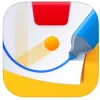Take a look inside 5 images
Newton for Osmo
Pros: It's novel and will likely draw kids in.
Cons: Sensitive camera picks up on every little line.
Bottom Line: Though it's a fun concept, Newton can frustrate or challenge, depending on how it's framed and supported by teachers.
Use Newton for Osmo to introduce students to the basics of physics and how objects react to others. As the levels increase, so does the physics, with obstacles such as walls or spinning fans. Since the camera picks up on any lines, kids will have to do some creative problem solving, too, to maneuver those objects to direct the bouncing balls. They can draw the lines on paper, use one of their hands, or grab another object to direct the balls. The games move fast, so students don't have much time to think or reflect on their moves, but they can certainly get a grasp of how objects affect other objects. Teachers will want to plan time to debrief and reinforce the concepts.
Newton for Osmo is a free download that accompanies the basic gaming system from Osmo. The system, which includes two other apps and toys, retails for $79.99. It comes with a base and a reflector attachment that clips over the iPad's camera. The base fits any iPad, only requiring a slightly different configuration for the iPad Air and Mini. The device will have to be removed from its cover, so parents may want to help younger kids with the setup. To play, kids only need paper and a pen along with the system. Teachers can register with Osmo to set up multiple player accounts on their devices.
Think of Newton for Osmo like a draw-as-you-play pinball machine. Each level presents different obstacles, but the object is to collect points as quickly as possible by drawing lines that the falling balls bounce off to hit the target. After completing the level, players see their time and get a score of one to three stars and can then advance to the next unlocked level. The reflector attachment on the system allows it to see what players draw on actual paper, and that is then reflected on the device’s screen.
The technology involved in interacting with paper and the screen is jaw-dropping, but the implementation can cause frustration. The camera picks up any lines, not only those drawn on paper. This means that the lines on your hand, the grain of the wood on the table, and anything else the reflector sees will show up as a line in the game. Some kids may find this frustrating; however, it can also be a learning opportunity if framed as such. Using lines from the environment vs. drawn lines may actually be necessary, too, because kids could run through a lot of paper if they create new lines for each puzzle. That might mean they'd need a fresh sheet of paper for each round of gameplay, which could quickly get wasteful.
The lesson plans encourage students to use other objects, such as the puzzle pieces from Osmo Tangram, which encourages creative problem-solving and could be incorporated into a lesson in and of itself. Overall, this is a fun way to explore motion and shapes, but it'll miss the mark on connecting kids with explicit insights about art or physics without teacher support and extension.














